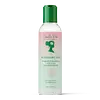What's inside
What's inside
 Key Ingredients
Key Ingredients

 Benefits
Benefits

 Concerns
Concerns

 Ingredients Side-by-side
Ingredients Side-by-side

Glycerin
HumectantPropanediol
SolventOlea Europaea Fruit Oil
MaskingPEG-40 Hydrogenated Castor Oil
EmulsifyingRosmarinus Officinalis Leaf Oil
MaskingHoney
HumectantRosmarinus Officinalis Flower/Leaf/Stem Extract
MaskingWater
Skin ConditioningLactic Acid
BufferingGlycolic Acid
BufferingVaccinium Myrtillus Fruit Extract
Skin ConditioningSaccharum Officinarum Extract
MoisturisingCitric Acid
BufferingCitrus Aurantium Dulcis Fruit Extract
MaskingCitrus Limon Fruit Extract
MaskingAcer Saccharum Extract
Skin ConditioningTartaric Acid
BufferingMalic Acid
BufferingMentha Piperita Oil
MaskingPhenoxyethanol
PreservativeEthylhexylglycerin
Skin ConditioningCI 77288
Cosmetic ColorantCurcuma Longa Root Extract
MaskingSpirulina Platensis Extract
Skin ProtectingGlycerin, Propanediol, Olea Europaea Fruit Oil, PEG-40 Hydrogenated Castor Oil, Rosmarinus Officinalis Leaf Oil, Honey, Rosmarinus Officinalis Flower/Leaf/Stem Extract, Water, Lactic Acid, Glycolic Acid, Vaccinium Myrtillus Fruit Extract, Saccharum Officinarum Extract, Citric Acid, Citrus Aurantium Dulcis Fruit Extract, Citrus Limon Fruit Extract, Acer Saccharum Extract, Tartaric Acid, Malic Acid, Mentha Piperita Oil, Phenoxyethanol, Ethylhexylglycerin, CI 77288, Curcuma Longa Root Extract, Spirulina Platensis Extract
Water
Skin ConditioningGlycerin
HumectantPolysorbate 20
EmulsifyingCetrimonium Chloride
AntimicrobialAloe Barbadensis Leaf Juice
Skin ConditioningApium Graveolens Seed Extract
AntioxidantAsparagus Racemosus Root Extract
AntimicrobialBiotin
AntiseborrhoeicCamellia Sinensis Leaf Extract
AntimicrobialCaprylic/Capric Triglyceride
MaskingCholecalciferol
Equisetum Arvense Extract
AstringentGinkgo Biloba Leaf Extract
Skin ConditioningLonicera Japonica Flower Extract
Skin ConditioningMoringa Oleifera Seed Oil
EmollientPanthenol
Skin ConditioningRetinyl Palmitate
Skin ConditioningSerenoa Serrulata Fruit Oil
Skin ConditioningTocopheryl Acetate
AntioxidantUrtica Dioica Extract
AstringentBenzophenone-4
UV AbsorberBenzyl Salicylate
PerfumingHydroxycitronellal
PerfumingLimonene
PerfumingLinalool
PerfumingBenzyl Alcohol
PerfumingDehydroacetic Acid
PreservativePhenoxyethanol
PreservativeCI 42090
Cosmetic ColorantAminomethyl Propanol
BufferingParfum
MaskingWater, Glycerin, Polysorbate 20, Cetrimonium Chloride, Aloe Barbadensis Leaf Juice, Apium Graveolens Seed Extract, Asparagus Racemosus Root Extract, Biotin, Camellia Sinensis Leaf Extract, Caprylic/Capric Triglyceride, Cholecalciferol, Equisetum Arvense Extract, Ginkgo Biloba Leaf Extract, Lonicera Japonica Flower Extract, Moringa Oleifera Seed Oil, Panthenol, Retinyl Palmitate, Serenoa Serrulata Fruit Oil, Tocopheryl Acetate, Urtica Dioica Extract, Benzophenone-4, Benzyl Salicylate, Hydroxycitronellal, Limonene, Linalool, Benzyl Alcohol, Dehydroacetic Acid, Phenoxyethanol, CI 42090, Aminomethyl Propanol, Parfum
Ingredients Explained
These ingredients are found in both products.
Ingredients higher up in an ingredient list are typically present in a larger amount.
Glycerin is already naturally found in your skin. It helps moisturize and protect your skin.
A study from 2016 found glycerin to be more effective as a humectant than AHAs and hyaluronic acid.
As a humectant, it helps the skin stay hydrated by pulling moisture to your skin. The low molecular weight of glycerin allows it to pull moisture into the deeper layers of your skin.
Hydrated skin improves your skin barrier; Your skin barrier helps protect against irritants and bacteria.
Glycerin has also been found to have antimicrobial and antiviral properties. Due to these properties, glycerin is often used in wound and burn treatments.
In cosmetics, glycerin is usually derived from plants such as soybean or palm. However, it can also be sourced from animals, such as tallow or animal fat.
This ingredient is organic, colorless, odorless, and non-toxic.
Glycerin is the name for this ingredient in American English. British English uses Glycerol/Glycerine.
Learn more about GlycerinPhenoxyethanol is a preservative that has germicide, antimicrobial, and aromatic properties. Studies show that phenoxyethanol can prevent microbial growth. By itself, it has a scent that is similar to that of a rose.
It's often used in formulations along with Caprylyl Glycol to preserve the shelf life of products.
Water. It's the most common cosmetic ingredient of all. You'll usually see it at the top of ingredient lists, meaning that it makes up the largest part of the product.
So why is it so popular? Water most often acts as a solvent - this means that it helps dissolve other ingredients into the formulation.
You'll also recognize water as that liquid we all need to stay alive. If you see this, drink a glass of water. Stay hydrated!
Learn more about Water